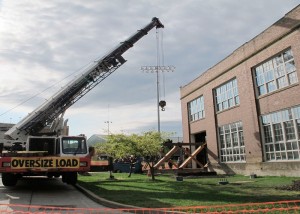
It was a bridge project that went on without tying up traffic—and, in fact, without many people knowing: Yesterday, contractors moved two 13,000-pound wooden bridge trusses out of the structures lab at Case Western Reserve University and onto pilings outside the building, to kick off a yearlong research project. The trusses, made of wood, are 11 feet high by 48 feet long and are of the same design Cleveland industrialist Amasa Stone used to build railroads across the U.S.
The trusses were part of a New Hampshire bridge built 86 years ago but recently burned by arson. Using timbers from Oregon, it was rebuilt in New Hampshire, disassembled and shipped to Civil Engineering Professor Dario Gasparini.
The trusses have been reassembled in the Case Western Reserve lab and are held together with long bolts torqued at 80,000 pounds of pressure each and wired with 44 sensors for a yearlong research project on the effects of temperature, moisture and pressure over time. The goal is to provide engineers with information they can use when rehabilitating these bridges; more than 150 still exist.
 William Howe patented the bridge design in 1840; the rights were later bought by Howe’s brother-in-law, Amasa Stone, who moved to Cleveland and built railroad bridges.
William Howe patented the bridge design in 1840; the rights were later bought by Howe’s brother-in-law, Amasa Stone, who moved to Cleveland and built railroad bridges.
Stone and his family were great benefactors of what is now Case Western Reserve. Evidence can be found across campus: Amasa Stone Chapel; Adelbert Hall, formerly called Adelbert College, named for Stone’s son who drowned while at Yale University; and the Mather buildings, named for his daughter, Flora Stone Mather.
